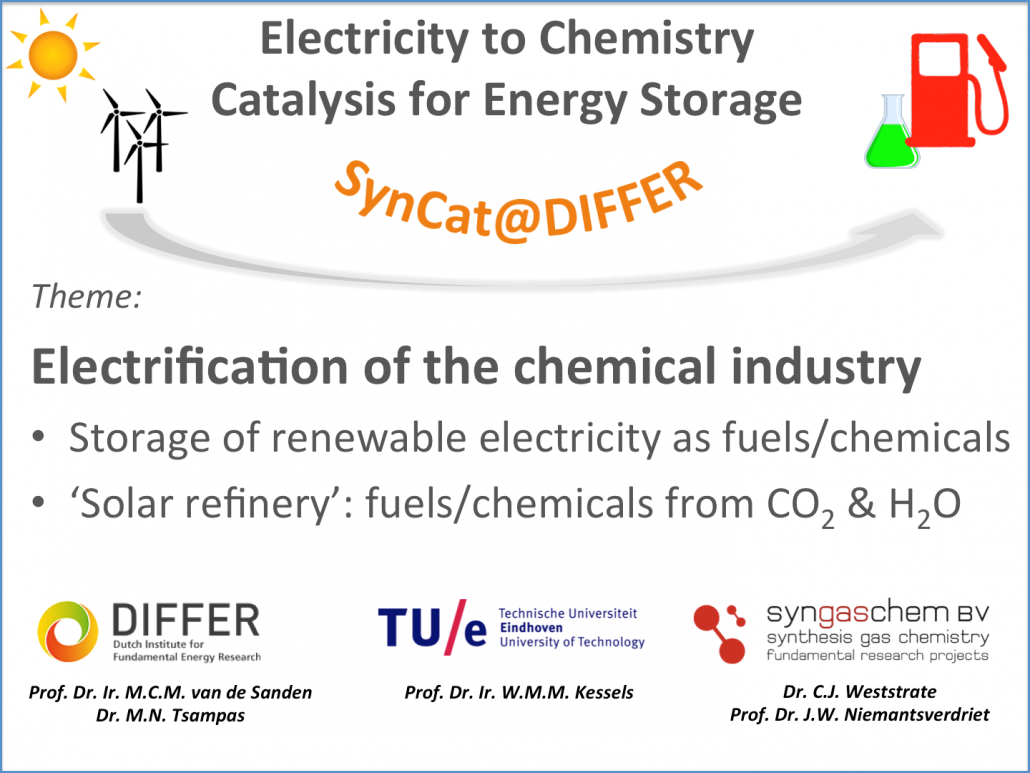Fuel from sunlight – carbon dioxide, water and green electricity as building blocks for sustainable chemistry
Richard van de Sanden (Director DIFFER), Erwin Kessels (Professor of Physics, Eindhoven University of Technology) and Kees-Jan Weststrate (Syngaschem BV) have been granted a substantial subsidy to make liquid fuels from green electricity, water and carbon dioxide. They will work together to gain understanding of the fundamental principles behind this form of fuel production. To enable the collaboration, Syngaschem BV teams up with two funding agencies, the Foundation for Fundamental Research on Matter (FOM) and the Netherlands Organisation for Scientific Research (NWO) – Chemical Sciences in this Industrial Partnership Programme with a total budget of approximately 1.6 Million Euro. The program also foresees in close international collaboration with the SynCat@Beijing laboratory of Synfuels China Technology.
Due to the rapid growth of green electricity production there is a need for chemical processes that can use electricity instead of fossil raw materials. For example, this is relevant for the large-scale use of sustainable, fluctuating energy sources such as wind turbines and solar panels. By converting temporary electricity surpluses into liquid fuel, a sustainable energy infrastructure is created.
The researchers from the Netherlands Institute for Fundamental Energy Research DIFFER, the Department of Applied Physics at Eindhoven University of Technology and the company Syngaschem BV are joining forces to efficiently convert green electricity into liquid hydrocarbons with a high energy density, such as gasoline or diesel.
Kees-Jan Weststrate (Syngaschem BV, project manager) explains: “If we can understand this specific form of fuel production then at the same time we will also create opportunities for the production of other high-value chemical products. Products based on carbon are an indispensable part of our society and with this approach we can continue to produce those chemicals without a need for fossil sources.”
DIFFER director Richard van de Sanden is pleased with this new collaboration: “The large-scale and efficient storage of sustainable energy is what the energy transition is all about. How do we ensure that clean energy is available when and where the user needs it? Many concepts exist but these often still have a low yield. Fundamental research in collaboration with industry is needed to improve the yield. Only then will you know for certain that you are addressing the right challenge to make the large-scale application of your idea possible.”
At the boundary of chemistry and physics
The research has both chemical and physical aspects: partners are active in the area of electrochemistry, catalysis, surface reactions, spectroscopy and plasma physics. NWO Chemical Sciences (CW) and the Foundation for Fundamental Research on Matter (FOM) therefore sought collaboration and a multidisciplinary research programme has been realised: a mix of an Industrial Partnership Programme (IPP) from FOM and a Chemical Industrial Partnership Programme (CHIPP) from NWO CW.
Top Sector Chemistry & Energy in The Netherlands
The research falls within the scope of the Top Sectors Chemistry and Energy, and the Innovation Fund Chemistry (IFC) of CW – an instrument through which NWO is contributing to the Top Sector Chemistry.
Read more in the Press Release. (LINK for download)
Photo at the right: Researchers Kees-Jan Weststrate (Syngaschem BV), Erwin Kessels (Eindhoven University of Technology) and Michail Tsampas (DIFFER) (from left to right) are working together on the conversion of sunlight into fuel (Bram Lamers / DIFFER)
Published on April 7, 2016




